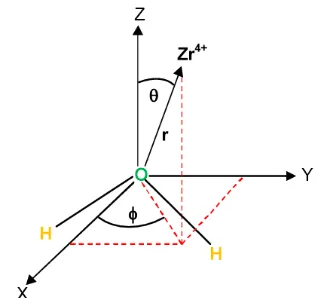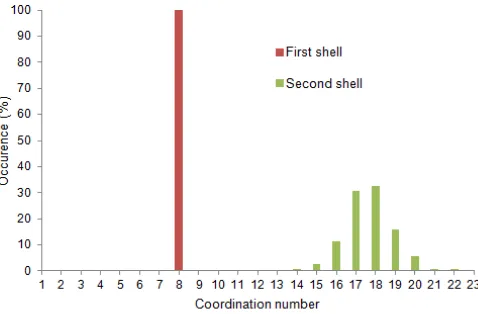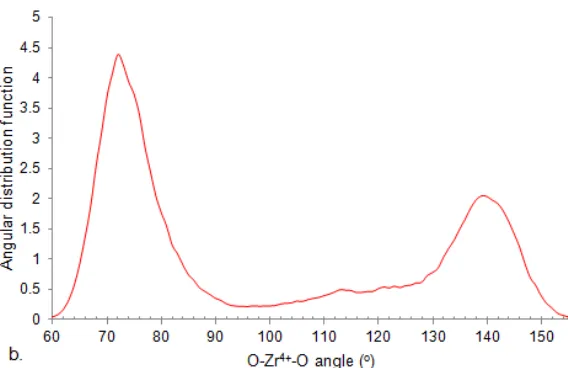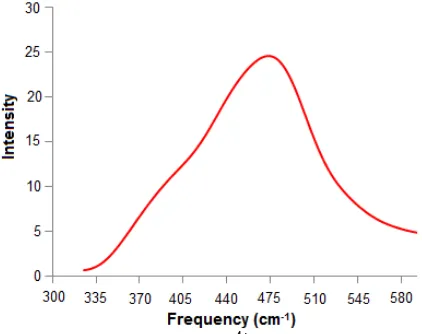STRUCTURE AND DYNAMICS OF Zr
4+IN AQUEOUS SOLUTION: AN AB INITIO
QM/MM MOLECULAR DYNAMICS STUDY
Suwardi
1,2, Harno Dwi Pranowo
2and Ria Armunanto
2,*1
Department of Chemistry Education, Faculty of Mathematics and Natural Sciences, Yogyakarta State University, Jl. Colombo 1, Yogyakarta, Indonesia
2
Austrian-Indonesian Centre for Computational Chemistry, Department of Chemistry,
Faculty of Mathematics and Natural Sciences, Universitas Gadjah Mada, Sekip Utara, Yogyakarta 55281 Indonesia Received October 6, 2014; Accepted March 2, 2015
ABSTRACT
A QM/MM molecular dynamics (MD) simulation has been carried out using three-body corrected pair potential to investigate the structural and dynamical properties of Zr4+in dilute aqueous solution. Structural data in the form of radial distribution function, coordination number distribution, and angular distribution function were obtained. The results indicate eight water molecules coordinate to zirconium ion and have two angles of O-Zr4+-O, i.e. 72.0° and 140.0° with a Zr4+-O distance of 2.34 Å. According to these results, the hydration structure of Zr4+ion in water was more or less well-defined square antiprismatic geometry. The dynamical properties have been characterized by the ligand’s mean residence time (MRT) and Zr4+-O stretching frequencies. The inclusion of the three-body correction was important for the description of the hydrated Zr4+ ion, and the results indicated in good agreement with experimental values.
Keywords:hydration; ions in solution; molecular dynamics; QM/MM; Zr4+
ABSTRAK
Simulasi Dinamika Molekuler (DM) MK/MM menggunakan potensial pasangan terkoreksi potensial tiga badan telah digunakan untuk menyelidiki sifat-sifat struktur dan dinamika Zr4+ dalam larutan berair encer. Data struktural dalam bentuk fungsi distribusi radial, distribusi bilangan koordinasi, dan fungsi distribusi sudut telah berhasil dianalisis. Hasil analisis menunjukkan delapan molekul air terkoordinasi pada ion zirkonium dengan dua sudut O-Zr4+-O, yaitu 72,0° dan 140,0° dan jarak Zr4+-O 2,34 Å. Sesuai data ini, maka geometri struktur hidrasi ion Zr4+dalam air adalah bujursangkar antiprismatik. Sifat dinamika dikarakterisasi melalui waktu tinggal rata-rata ligan dan frekuensi ulur Zr4+-O. Penambahan koreksi tiga badan penting dalam menggambarkan hidrasi ion Zr4+dan hasilnya sesuai dengan harga eksperimental.
Kata Kunci:hidrasi; ion dalam larutan; dinamika molekuler; MK/MM; Zr4+
INTRODUCTION
Structure and dynamics hydrated Zr4+have been a challenging subject for experimentalist and theoretician. The structure of the hydrated Zr4+ ions has been determined in concentrated aqueous perchloric acid by means of EXAFS, with the ion being eight-coordinated, most probably in square antiprismatic fashion, with mean Zr4+–O bond distances of 2.187 Å [1].
The Zr has a low neutron capture cross-section and a high resistance to corrosion and as an essential commodity for the nuclear industry. Present interest in the solution chemistry of Zr arises from several perspectives including the problem of radioactive waste management [2].
structural and dynamical properties of this hydrate is highly desirable in the development of solvent extraction methods especially for separation of zirconium.
The structure of ZrOCl2ˑ8H2O was analyzed by the
EXAFS method. The Zr4+–O distance in this crystal is 2.22 ± 0.02 Å [4]. In general experiments investigations were used to determine the structure and dynamics of metal ions in solution by a variety of spectroscopic techniques such as nuclear magnetic resonance (NMR), extended X-ray absorption fine structure spectroscopy (EXAFS), Mössbauer, infrared (IR), and Raman spectroscopy, and scattering techniques such as X-ray, electron and neutron diffraction, and by theoretical methods, mostly simulations of the Monte Carlo (MC), quantum mechanics/molecular mechanics molecular dynamics (QM/MM MD) and quantum mechanics charge field (QMCF) [5-6].
Besides experimental investigations, computer simulations especially using QMCF-MD methods was applied to characterize the hydration of Zr4+, U4+, Np4+, Ce4+, and Hf4+ ions [7-9]. However, the methods of classical and QM/MM MD was used to evaluate structure of trivalent ions such as Cr3+, Co3+, Ti3+, La3+, Bi3+, and Al3+ successfully whereas for tetravalent ions (M4+) were unknown so far [10-13]. Hence, Zr4+ as one of tetravalent ions was interesting to investigate by the QM/MM MD method. In this study, the Zr4+ in aqueous solution was reinvestigated using QM/MM MD simulation based on three-body corrected pair potential to achieve a reliable description of the structure and dynamics of the Zr4+hydrate.
METHODS
Selection of Basis Sets
The basis sets of DZP for H2O and the modified
LANL2DZ ECP for Zr4+ ion were selected in calculating energy of water-Zr4+ ion interactions. In particular, the basis sets of LANL2DZ ECP was modified because the charge transfer effects due to larger Zr4+-water distances, and deviating from Lennard-Jones (12-6) curve profile as shown in Fig. 1. The modification of LANL2DZ ECP was performed by removing some basis functions with exponents below 0.5 so that this charge transfer effects were not occurred. That modification is reasonable in physical term as Zr4+ ion radius (0.7 Å) is much smaller than Zr atom radius (1.54 Å) for which the more diffuse basis functions have been adopted. The global minimum energies obtained by the original and the modified basis sets are -200.00 and -141.22 kcal/mol at the identical rZr
4+
-O of 2.2 Å for Zr 4+
. Because the calculations were carried out to construct pair potential functions for classical MD simulations, the observed increase in energy could be tolerated, as the absolute
Fig 1. Energy curves for Zr4+–water interactions are obtained from ab initio calculations with unmodified and
modified LANL2DZ ECP basis sets
Fig 2. Definition of geometric variables for Zr4+-H2O
configuration
energy values do not play such an important role for the evaluation of structural properties [14].
Construction of Ion-Water Pair Potential
To construct the Zr4+-H2O pair potential, we must
adjusted some geometrical parameters like distances and angles. The Zr4+ ion was placed at numerous positions around the water molecule by varying
geometrical parameters 0° ≤ ≤ 180° and 0° ≤ ≤ 90°;
for each configuration, the Zr4+-O internuclear distance
r was varied from 1.4 to 15.0 Å (Fig. 2). The internal geometric parameters of water were held fixed at the experimental values, i.e., rOH = 0.960 Å and ∠HOH =
104.47° [15]. The quantum mechanics calculations were performed at the RHF level using the TURBOMOLE program [16]. The interaction energies,
∆E2bd,between zirconium ion and water were calculated
species Zr4+and H2O are denoted by 4 2 ( ) Zr H O
Table 1. The optimized parameters of the analytical 2-body potential function of Zr4+ -water interactions in Åm kcal/mol (m is exponent according to Eq. (3)) and the analytical 3-body potential function of water-Zr4+-water interactions
2-body
AO BO CO DO
Zr4+-O -10227.48 409574.39 -1826459.83 1570267.42
AH BH CH DH
Zr4+-H -540.73 2657.28 -2086.54 274.31
3-body
F(kcal/mol Å-4) G(Å-1) H(Å-1) H2O-Zr4+-H2O 0.1699019 0.4868692 -0.3429535
and 2 H O
E , respectively [17-18].
4 4
More than 8000 water-ion configurations were used in the construction of the pair potential using a modified LANL2DZ ECP basis sets for Zr4+ and Dunning DZP basis sets for oxygen and hydrogen. The 2-body energies were fitted to an analytical form,
2
where M denotes metal ions, i solvent atoms, n the number of atoms in solvent molecule, A, B, C, and D are optimized parameters and q represents the atomic charge. The a, b, c and d are exponents (m) taking values in a range from 4–12. For Zr4+-H2O system, the
The charges were set to 4.0 for Zr4+ and -0.6598 and 0.3299 for O and H, respectively, corresponding to the BJH-CF2 water model. The final parameters for 2-body potential function are listed in Table 1.
Construction of Analytical 3-Body Function
Construction of 3-body potential as a correction of 2-body potential based on interaction energies of three species, H2O-Zr4+-H2O. To construct it, more than
17,000 interaction points of H2O-Zr 4+
-H2O was calculated
using the TURBOMOLE program. The obtained data were fitted to an analytical form by Levenberg-Marquardt algorithm. the ion-oxygen distances for water molecules are denoted by r12 and r13, respectively whereas r23 is the
oxygen-oxygen distances between two water molecules. The cutoff radius rcut is set to 6.0 Å after
which 3-body effects can be ignored. The root mean square deviation (rmsd) of the fitted function was 0.8189284 kcal/mol. The final parameters F, G, H are listed in Table 1.
Simulation Protocol
The simulations were carried out in the NVT canonical ensemble, consisting of one Zr4+ion and 499 water molecules in a periodic box of 24.77 at 298.16 K, which is maintained through the Berendsen algorithm. The density of system is considered to be equal to the density of pure water is 0.99702 g cm-3. A cutoff of 12 Å was set except for O-H and H-H non-Coulombic interaction where it was set to 5 and 3 Å. The reaction field method was used to account for long-range electrostatic interactions. For the water-water interactions BJH-CF2 water model containing intramolecular term, has been used. In accordance with this water model, the time step of the simulation was set to 0.2 fs, which allows for explicit movement of hydrogens [19-20].
QM/MM-MD Simulation
The classical MD simulations were performed for 204 ps by two steps. The first step, simulation was run using pair potential function during 102 ps, starting from a random configuration. After which simulation continued with pair plus 3-body potentials for 102 ps. Subsequently, the QM/MM simulation was carried out for more 50 ps. The quantum mechanical treatments around the metal ion had a radius of 3.8 Å and water molecules were permitted to leave and enter from and to this region dynamically. The size of this region includes the full first hydration shell at any step of the simulation. A smoothing function was given in the transition region between QM and MM forces. The forces of system,Fsystem, is defined as:
/
( )
System MM QM QM MM
F F S F F (5)
Fig 3.Zr4+-O and Zr4+-H radial distribution functions and their running integration numbers for Zr4+in water
Fig 4. Coordination number distributions (CND) of the first and second hydration shell of Zr4+ in water obtained from a QM/MM MD simulation until 30 ps
Table 2.Comparison of hydration parameters obtained from various methods for Zr4+in water
Samples r
(1) Zr4+-O
(first shell) n1 n2 Methods References
1 Zr4+in 499 H2O 2.25 10 ~23 2bd-Classical MD This work
Zr-exchanged beidellite 2.21 ± 0.01 8 ± 0.3 - EXAFS [4]
pillared beidel-lite (PB) 2.16 ± 0.02 6.1 ± 1.4 - EXAFS [4]
1 Zr4+in 1000 H2O 2.25 8 17.8 QMCF [5]
r(1)is the distance in Å for the first maxima of RDF, n1and n2are the average coordination number of the first and second shell, respectively. force of the system, FQM is the QM force in the QM
region andFQM/MMis the MM force in the QM region. The S denotes the smoothing function. Free migration of water ligand between the QM and MM region is enabled in this approach.
wherer1andr0are the ion-water distances indicating the
start and end of the shell, where smoothing applies [21-22].
RESULT AND DISCUSSION
The Zr4+-O and Zr4+-H radial distribution functions for QM/MM molecular dynamics simulations are shown in Fig. 3. The RDF of Zr4+-O reveals well-defined structures for the first and the second hydration shell. The first shell peaks at 2.34 Å and separated from the second shell by a minimum and reaches the x- axis. This
indicates ligand exchange have been not taken place along the simulation trajectory. The second shell peak of the Zr4+–H RDF is overlapping with the respective peak of the Zr4+–O RDF within a long range and hence, the flexibility of the second shell is very high. The third shell is almost indistinguishable from the bulk. A maximum peak is located at 4.755 Å with a broad peak observed between 4.0 and 5.4 Å corresponds to a second hydration shell containing in average of 17.2 water molecules. The Zr4+-O distance of 2.34 Å is in good agreement with EXAFS investigation, namely 2.22 ± 0.02 Å [4].
Fig 5. a. Square antiprism structure of the first hydration shell and a number of water molecules forming hydrogen bond in the second hydration shell of Zr4+ in water (Snapshot taken by tmolex); b. Distribution of the bond angles H2O-Zr
4+
-H2O for QM/MM-MD simulations
whereas a quantum mechanical treatment accounts for all polarization and charge transfer effects and thus also the charge fluctuations on the central ion. The influence of polarization in classical simulations has been investigated by Meier et al., who indeed reported an increased ion–oxygen bond length, but no change in the coordination number [23].
The distributions of the coordination numbers in the first and the second hydration shells are evaluated, as depicted in Fig. 4. The obtained eight-coordinated complex in the first hydration shell (100% occurrence) is in agreement with EXAFS and QMCF data. This indicates the rigidity of first hydration shell structure. The coordination number for the second solvation shell range 14-20 with average of 17.2, implying that every first shell water molecule interacts with about 2.15 water molecules in the second shell.
The hydration structure may be indicated from angular distribution functions (ADF). Fig. 5 shows distribution of oxygen-zirconium-oxygen angle within the first hydration shell and snapshot a number of water
molecules. The ADF peaks at 72 and 140° between the two maxima a valley ranging from 90 to 128° was observed. Two sharp peaks clearly separated from each other towards a defined structure with quite rigidity within the first shell. The square antiprism seems to match best to the structure of first hydration shell.
The orientation of water molecules in the first and second hydration shell can be discussed on the basis of two angle parameters i.e. theta and tilt angle. The theta is the angle between the Zr4+-O vector and the resulting vector obtained from the sum of the O-H bonds whereas tilt is defined by the Zr4+-O vector and the plane spanned by the water molecule. The theta and tilt angle distributions within the first and second hydration shell are depicted in Fig. 6. The theta angle distribution shows the highest peak at 173°, the smallest angle recorded has a value of 150° in the first shell. This narrow peak shows the low angular flexibility of ligands in the Zr(H2O)8
4+
Fig 6.Tilt (Out-of-plane) angle distributions and Theta angle distributions (angle between dipole vector and Zr4+–O connection vector) of first and second shell obtained by QM/MM–MD simulations
Fig 7. Power spectrum of Zr4+-oxygen vibrational mode in the first hydration shell obtained by QM/MM simulations
Table 3. The parameter of H–O–H angles and O–H distances of water molecules in three phases observed in QM/MM Molecular Dynamics simulations of Zr4+ion
Ion Phase r (O-H)/(Å) H-O-H angle (°) First hydration shell 0.968 101 Second hydration
shell 0.973 101
Zr4+
Bulk 0.973 101
of the -angle towards lower angles is related with the strong Zr4+–water interaction leading to slow motion of the water molecules. Furthermore, the angles correspond to water molecules that are nearly perfectly dipole oriented. The water molecules of the second hydration shell still exhibit this feature, but with a naturally broader distribution with significant population down to about 60 and a maximum at 150. The tilt-angle distribution is very broad and the maximum at 0° (± 9° at half height) further demonstrates the high stability of the first shell ligands. As comparisons, tilt angle distribution for Zr(IV), Al(III), Ni(II) are ± 30°, ± 35°, ± 50°,
respectively. The stronger polarizing ion tends to have low degree of flexibility [14].
The strong ion–ligand bonding deduced from the
structural properties is reflected in the Zr4+
–O vibrational mode as well. The power spectra of the Zr4+–O stretching motion obtained by QM/MM simulations is displayed in Fig. 7. The frequency of Zr4+-O stretching mode is 476.81 cm-1, the corresponding force constant 182.53 N m-1 while
according to QMCF m
ethod of 188 N m-1 [5]. This value indicates strong ligand bonding occurring to take place in the first hydration shell. Therefore, no frequent ligand exchange between the first and the second shell.
The values of H–O–H angles and O–H distances with the maximum intensity in the first hydration shell are about 101° and 0.968 Å, respectively as depicted in Fig. 8. Experimental gas phase values were used for the water (O–H = 0.9601 Å and H–O–H =104.47°) [9]. The Zr4+ ion has a small influence on the water geometry in the first shell, leading to an elongation of the O-H bond of 0.01 Å and a reduced H-O-H angle of 3.47°. The values of H–O–H angles and O–H distances observed from the simulations are summarized in Table 3.
Table 4.Mean ligand residence times (MRT) in ps, number of accounted exchange events (Nex) obtained by direct
method as a function oft* and sustainability coefficient (Sex)
t*= 0 ps t*= 0.5 ps tsim/ps 0
ex
N Nex0.5
Sex 1/Sex
Second shella 50.50 6356 0.276 322 5.456 0.051 19.74
Bulkb 10.00 269 0.200 24 1.700 0.090 11.11
aAs comparison, MRT = 5.5 ps using QMCF method [5] b
Values obtained from a QM/MM MD simulation of pure water [26]
Fig 8. a. The angle and bond-length distribution of water molecules in the first, and second hydrations shell and in bulk
Fig 9. Variation of Zr4+ ion-oxygen distances during the QM/MM simulation showing no exchange processes between first and second hydration shells until 30 ps. After simulations 30 ps ligand migration was observed
Based on direct accounting and setting the time parameter t* to 0 (all movements out of shell are accounted) and 0.5 (only exchange processes leading to a longer-lasting removal of a ligand. The MRT values listed in Table 4 were obtained. Mean ligand residence times () in ps and number of accounted exchange events (Nex) as a function of t
*
evaluated by direct method. Besides mean ligand residence times, the simulation can supply properties of ions in terms of lability of the hydration shell and sustainability of
exchange processes. Sustainability measures the rates of success of exchange events in leading to longer lasting changes in the hydration structure. A sustainability coefficient (Sex) can be defined as [12]:
0.5
0 ex ex
ex N S
N
(7)
where 0 ex
N is the number of all transitions through a shell boundary and means the number of changes persisting after 0.5 ps. The inverse, 1/Sex, represents
the average number of border-crossing attempts to produce one longer-lasting change in the hydration structure of an individual ion [14]. The MRT values in the second shell (5.456 ps) is much greater than that of water in bulk. This means that the mobility of water molecules in the second shell is smaller than in the pure solvent. The value of 0.051 was calculated for sustainability coefficient Sex of Zr
4+
, the corresponding 1/Sexis 19.74, which means that about 20 attempts to
leave or enter the second hydration shell are needed to achieve one lasting exchange process.
CONCLUSION
displacement of the water ligand of a second shell to first shell was observed. It indicated a more flexible second hydration shell. The dynamical properties of the hydration Zr4+ ion obtained by this method is in good agreement with QMCF method.
ACKNOWLEDGEMENT
Financial support for this work by the Dr. grant (No: 1853/E4.4/2011) from the Indonesian Government through the Directorate General of Higher Education while the software and hardware were supported by the Austrian-Indonesian Centre (AIC) for Computational Chemistry are gratefully acknowledged.
REFERENCES
1. Hagfeldt, C., Kessler, V., and Persson, I., 2004,
Dalton Trans., 14, 2142–2151.
2. Aja, S.U., Wood, S.A., and Williams-Jones, A.E., 1995,Appl. Geochem., 10, 603–620.
3. Lee, H.Y., Kim, S.G., and Oh, J.K., 2004,
Hydrometallurgy, 73(1-2), 91–97.
4. Miehé-Brendlé, J., Khouchaf, L., Baron, J., Dred, R.L., and Tuilier, M.H., 1997, Microporous Mater., 11(3-4), 171–183.
5. Messner, C.B., Hofer, T.S., Randolf, B.R., and Rode, B.M., 2011, Phys. Chem. Chem. Phys., 13, 224– 229.
6. Mohammed, A.M., 2003, Bull. Chem. Soc. Ethiop., 17(2), 199–210.
7. Messner, C.B., Hofer, T.S., Randolf, B.R., and Rode, B.M., 2011,Chem. Phys. Lett., 501(4-6), 292–295. 8. Lutz, O.M.D., Hofer, T.S., Randolf, B.R., Weiss,
A.K.H., and Rode, B.M., 2012,Inorg. Chem., 51(12),
6746−6752.
9. Frick, R.J., Pribil, A.B., Hofer, T.S., Randolf, B.R., Bhattacharjee, A., and Rode, B.M., 2009, Inorg. Chem., 48(9), 3993–4002.
10. Kritayakornupong, C., Yagüe, J.I., and Rode, B.M., 2002,J. Phys. Chem. A, 106(44), 10584–10589. 11. Hofer, T.S., Randolf, B.R., and Rode, B.M., 2006,
Chem. Phys. Lett., 422(4-6), 492–495.
12. Durdagi, S., Hofer, T.S., Randolf, B.R., and Rode, B.M., 2005,Chem. Phys. Lett., 406(1-3), 20–23. 13. Armunanto, R., Schwenk, C.F., Setiaji, A.H.B., and
Rode, B.M., 2003,Chem. Phys., 295(1), 63–70 14. Remsungnen, T., and Rode, B.M., 2004, Chem.
Phys. Lett., 385(5-6), 491–497.
15. Hofer, T.S., Randolf, B.R., and Rode, B.M., 2006,
J. Phys. Chem. B, 110(41), 20409–20417. 16. R. Ahlrichs, M. Br, H. Horn, M. Hser, C. Klmel,
Chem. Phys.Lett. 162 (1989) 165.
17. Yagüe, J.I., Mohammed, A.M., Loeffler, H., and Rode, B.M., 2001, J. Phys. Chem. A, 105(32), 7646–7650.
18. Pranowo, H.D., Wijaya, K., Setiaji, B., and Janu, R.S., 2002,Indones. J. Chem., 2(1), 1-7.
19. Armunanto, R., Schwenk, C.F., and Rode, B.M., 2003,J. Phys. Chem. A, 107(17), 3132–3138. 20. Tongraar, A., Liedl, K.R., and Rode, B.M., 1997,J.
Phys. Chem. A, 101(35), 6299–6309.
21. Vchirawongkwin, V., Kritayakornupong, C., and Tongraar, A., 2011,J. Mol. Liq., 163(3), 147–152. 22. Loeffler, H.H., Yagüe, J.I., and Rode, B.M., 2002,
Chem. Phys. Lett., 363(3-4), 367–371.
23. Hofer, T.S., Scharnagl, H., Randolf, B.R., and Rode, B.M., 2006,Chem. Phys., 327(1), 31–42. 24. Kritayakornupong, C., 2007, Chem. Phys. Lett.,
441(4-6), 226–231.
25. Armunanto, R., Schwenk, C.F., Tran, H.T., and Rode, B.M., 2004, J. Am. Chem. Soc., 126(8), 2582–2587.



